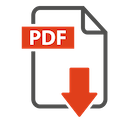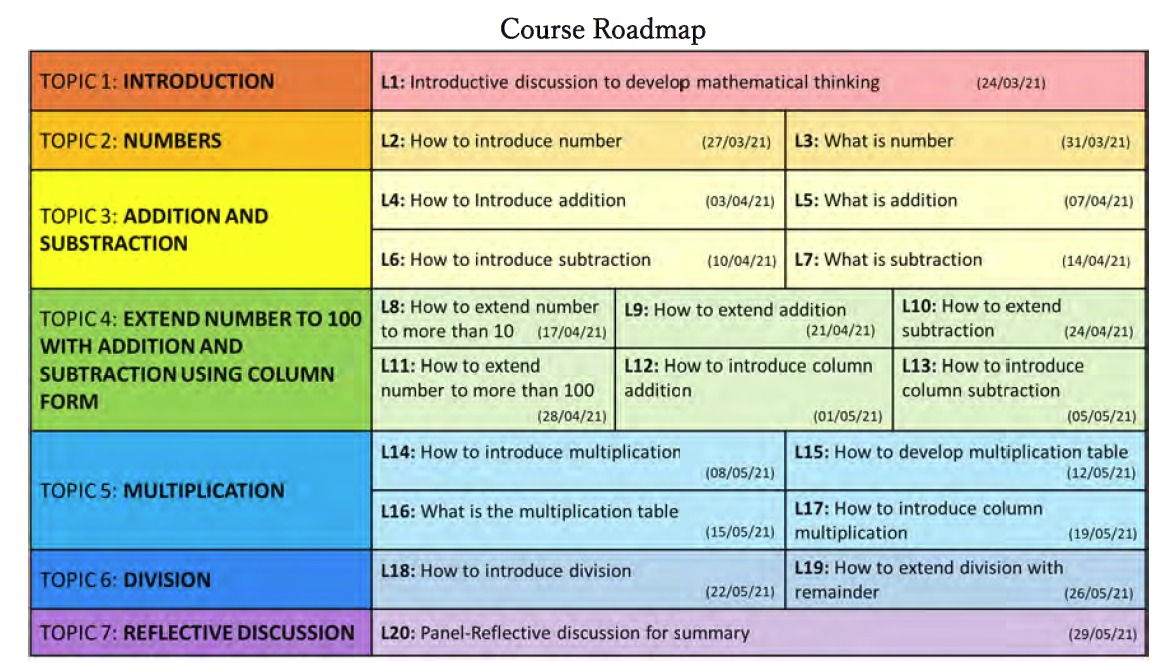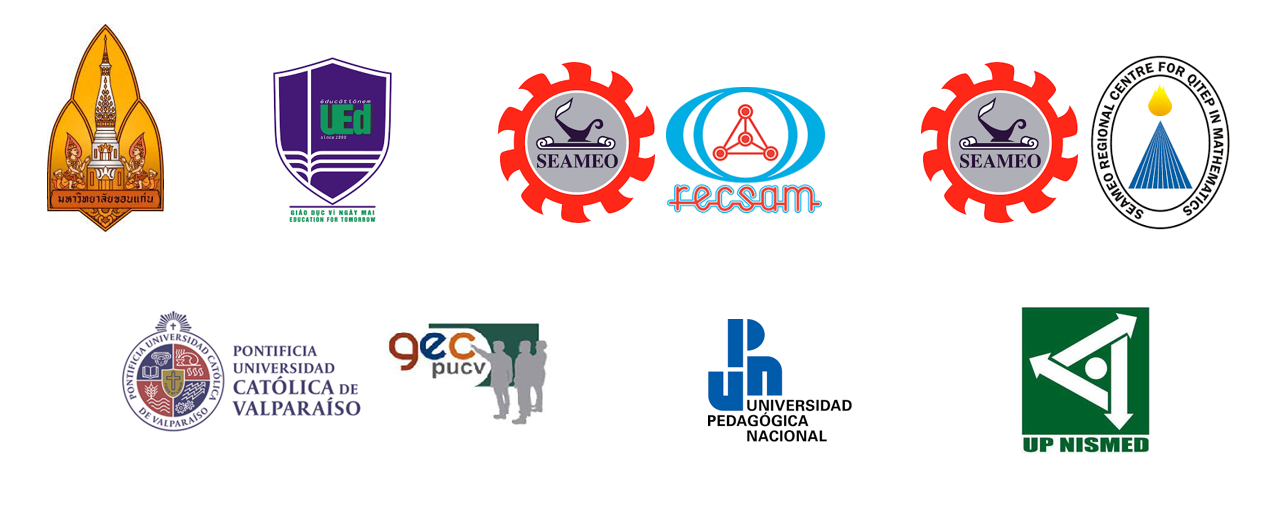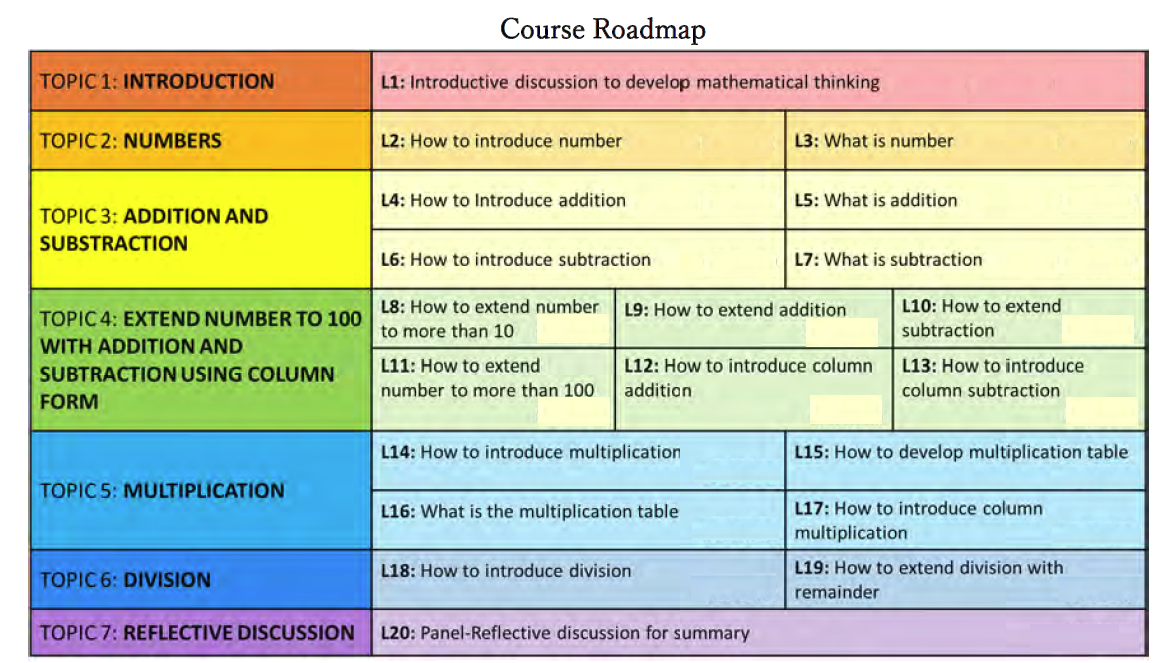

SEAMEO School Network from CRICED-University of Tsukuba
Teaching Mathematics to Develop Mathematical Thinking as Higher Order Thinking: How do you teach? Why? Number and Operation
Announcement
|
|
University of Tsukuba Online Program on Teacher Education*The schedule in this video has been updated. Please check the official announcement (.pdf) |

|
Announcement_for_SEAMEO_School_Network_from_CRICED-University_of_Tsukuba_1.pdf |
Samples for Lesson Format
|
|
Online streaming including Q&A from participants |
|
|
Implementation in Khon Kaen University, Thailand |

The twenty lessons were designed in a consecutive sequence such that the learned knowledge from past lessons is used. Thus, lessons cannot be skipped and the questionnaire is used to verify the attendance. As the participants answer the corresponding questionnaire, they will receive the URL for the next lesson. Certifications from CRICED will be provided as follows: Stage 1 up to Lesson 7, Stage 2 up to Lesson 13, Stage 3 up to Lesson 17 and Complete Program up to Lesson 20. Regarding textbook copyright-issues, which belong to Gakko Tosho (not CRICED), CRICED will provide the access to each YouTube video up to 10 days from the broadcasting day (it is not allowed to download). As a complement, a free .ppt file for each lesson composed by nine slides per page can be download from this webpage. Within this year, free books for task sequence will be published from SEAMEO RECSAM and an academic book for the development of Mathematical Thinking based on this course will be published, too.
Contents
Subprogram: Country's presentations and discussion with terminology.
Institutions represented by invited speakers

This program was successfully developed through the collaboration of invited guests, participants and supporters. Prof./PhD. Isoda, Masami, Director of CRICED, who developed the content of this program, deeply acknowledges their collaboration. In this program, Dr. Isoda used SEABES CCRLS for curriculum designers which was published by CRICED and SEAMEO RECSAM, and the English Edition of the Japanese Textbook which was published by Gakko Tosho.
Invited Guests:
Teh Kim Hong (SEAMEO-RECSAM, Malaysia)
Nguyen Chi Thanh (Vietnam National University-University of Education, Hanoi, Vietnam)
Aida Yap (Director of UP-NISMED, Philippines)
Wahid Yunianto (SEAMEO-QUITEP, Indonesia)
Maitree Inprasitha (Vice President of Khon Kaen University, Thailand)
Narumon Changsri (Director of IRDTP for ASEAN, Thailand)
Nisakorn Boonsena (Khon Kaen University, Thailand)
Raimundo Olfos (Pontificia Universidad Católica de Valparaiso)
Soledad Estrella (Pontificia Universidad Católica de Valparaiso)
Erlina Ronda (UP-NISMED, Philippines)
Marcela Santillan (Universidad Pedagogica Nacional)
Coordinator and MC:
Diego Solis Worsfold (CRICED)
Video editors:
Diego Solis Worsfold, Laura López, Mei Nakada (CRICED)
Supporters:
Wahyudi (Deputy Director of SEAMEO Secretariat)
Shah Jahan bin Assanarkutty (Director of SEAMEO Secretariat)
Sumardyono (Director of SEAMEO Qitep in Mathematics)
Auijit Pattanajak (Khon Kaen University)
Weerawan Theeraroungchaisri (SEAMEO Secretariat)
Web developer:
Yoneyama Takafumi (CRICED)
and all the Participants
This program was developed by using JSPS grant number 19H01662 for Isoda, Masami PhD. All rights reserved. This program used English Edition of Japanese textbook 'Study with your friends: Mathematics for elementary school', edited by Masami Isoda and Aki Murata, published from Gakko Tosho. Gakko Tosho has the copyright of the textbook. Dr. Isoda acknowledges its allowance to use for this program.
1. Textbook 'Study with your firends: Mathematict for Elementary School' 
Participants who would like to know the English Edition of Japanese textbook which was used in this program, please visit the following site:  . In the world, the following language editions are available: Thai edition, Mexican Edition, Papua New Guinea Edition, Chilian Edition and Indonesian Edition (the order is the year of publication). These editions have been published under projects by each government for their own country. If any country would like to collaborate on textbook development, please contact CRICED.
. In the world, the following language editions are available: Thai edition, Mexican Edition, Papua New Guinea Edition, Chilian Edition and Indonesian Edition (the order is the year of publication). These editions have been published under projects by each government for their own country. If any country would like to collaborate on textbook development, please contact CRICED.
2. SEABES-CCRLS and Mathematics Challenges series 
SEABES-CCRLS is a book for curriculum designers published by SEAMEO RECSAM and CRICED. Mathematics Challenges series are exercise books for teacher education under SEABES-CCRLS.
3. Isoda & Olfos (2021). Teaching Multiplication with Lesson Study. Springer 
It is an Open-Access book (free) which includes the explanation of Japanese Approach. It is the revision of the Spanish Edition and the addition of 10 years' progress.
4. Inprashita, Isoda, Wang-Iverson, & Yeap (2015).Lesson Study: Challenges in Mathematics Education. World Scientific 
It explains various perspectives of Lesson Study which includes Japanese Approach. Korean edition also exists.
5. Isoda & Katagiri (2012). Mathematical Thinking: How to Develop it in the Classroom. World Scientific 
It is English Edition of Katagiri's theory of mathematical thinking which originated in the 1960s and translated by Isoda. The introductory chapter is the explanation of Japanese teaching approaches by Isoda. Korean Edition of the theory also exists.
Program for all Teachers Colleges in Papua New Guinea

This program is the same as the Program for Southeast Asian Countries under the SEAMEO School Network.
The twenty lessons were designed in a consecutive sequence such that the learned knowledge from past lessons is used. Thus, lessons cannot be skipped.
At the end of each lesson, there is an announcement regarding questionnaires for getting the certification of the SEAMEO School Network Program, however we are not asking it to the lecturer of PNG.
If you would like to see the "Questions and Answers (Q&A)" session for each lesson on the SEAMEO School Network, please visit the "Course Roadmap, Description & Contents (#1)" shown above.
Contents
